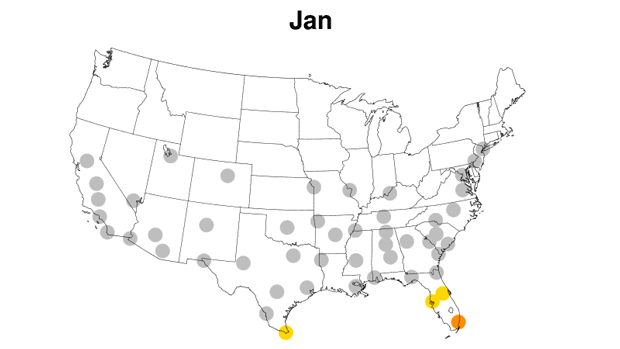Even as a trendy Miami neighborhood has been declared Zika-free, the mosquitoes that transmit the virus can continue to survive over the next few months across the southeast United States from Florida to Texas, research shows.
The potential for an abundant population of the Aedes aegypti mosquito remains moderate or even high through November in the southernmost cities in the country, according to a study, “On the seasonal occurrence and abundance of the Zika virus vector mosquito Aedes aegypti in the contiguous United States.”
Florida with its hot, humid weather is particularly vulnerable. In November, the threat will be high in and around Miami and moderate in Jacksonville, Orlando and Tampa, in New Orleans and in Houston and Brownsville, Texas.
Only in December will the risk decrease enough so that Miami alone will have a moderate potential for a significant supply of mosquitoes. Elsewhere in Florida, Louisiana and Texas there will still be some potential, though a low one.
Winter weather will be too cold for the mosquitoes elsewhere.

This animation shows the varying extent to which meteorological conditions can favor populations of the Aedes aegypti mosquito, which transmits the Zika virus, in 50 U.S. cities throughout the year. Red dots represent high-abundance conditions, orange represents medium-to-high, yellow represents low-to-medium, and gray represents no significant mosquito population. (Credit: ucar.edu)
“When a mosquito bites someone and gets a virus it needs a week or two depending on temperature to actually incubate a virus — for it to move from its mid gut up to its salivary glands,” said the study’s lead author, Andrew Monaghan, a scientist at the National Center for Atmospheric Research in Boulder, Colorado. “If you’re in cooler areas, not only is that slower but mosquitoes often won’t survive it long enough to go through that extrinsic incubation period.”
U.S. & World
The study, which looked at 50 cities within the range of Aedes aegypti, was published in March before locally transmitted cases of Zika were discovered in Florida — 70 cases in all, many in the Wynwood arts neighborhood of Miami and across Biscayne Bay in Miami Beach. Authorities in Florida say that they have found the virus in mosquitoes trapped in a 1.5-square-mile area of Miami Beach, a first for the continental United States.
On Monday, officials declared the first Zika outbreak on the continental United States to be over. No new cases of Zika have been found in Wynwood for 45 days, which represent three full incubation periods for the virus. However more cases were found in Miami Beach last week.
Monaghan and the study’s other authors had warned that the prevalence of Aedes aegypti would likely increase as the weather got warmer.
From New York to LA
Researchers found that conditions in the United States are mostly unsuitable for the mosquitoes from December through March, except in southern Florida and south Texas, where the potential for an abundant population is low to moderate.
In the peak summer months, July through September, the mosquito can thrive in all 50 cities -- as far north as New York City along the East Coast and as far west as Los Angeles across the southern portion of the country, according to computer simulations run by researchers at the National Center for Atmospheric Research and the NASA Marshall Space Flight Center. The mosquitoes are most abundant in the Southeast, particularly southern Florida, and south Texas where locally acquired cases of Aedes-transmitted viruses have been reported previously. Higher poverty rates in cities along the U.S.-Mexico border may result in increased exposure to the mosquito.
[NATL] Top News Photos: Pope Visits Japan, and More
But Zika is unlikely to spread widely in the United States as it has done in the Caribbean and Latin America, experts say. That’s because so many Americans live in air-conditioned homes and work in air-conditioned offices.
Zika was first identified in 1947 in Uganda, and has moved through tropical regions of the world over the past 10 years, according to experts.
The role of climate change
One question has been the role climate change is playing in the widespread Zika epidemic. Sharyn Stein, a climate scientist at the Environmental Defense Fund, said that though many factors can affect the spread of a disease like Zika, mosquito seasons are lasting longer.
“In some places it’s lasted three or four weeks longer than usual and so people will be exposed to mosquitoes carrying Zika for a lot longer period of time,” she said.
But how a warmer warm will influence the spread of the virus is not known, she said.
Much is not known about the virus and the latest mystery is how a dying man in Utah infected his son. Doctors in Utah warned that blood and other body fluids of people who are severely ill might be infectious.
Although most people with Zika have more mild symptoms, the disease can cause microcephaly in babies — and the accompanying devastating birth defects.
“While there is much we still don’t know about the dynamics of Zika virus transmission, understanding where the Aedes aegypti mosquito can survive in the U.S. and how its abundance fluctuates seasonally may help guide mosquito control efforts and public health preparedness,” Monaghan said when the study was released.
A battle over funding
President Obama has asked for $1.9 billion in emergency funding; Congress countered with $1.1 billion but has not passed the legislation. Republicans tried to prevent money from going to clinics in Puerto Rico run by ProFamilias, a Planned Parenthood partner, as part of their approval -- a provision Democrats have refused to agree to. This week, 77 mayors, including those of Miami Beach, Los Angeles, New York City, Chicago, Philadelphia and Boston, wrote to the Congressional leadership urging that Congress work together.
“Congress’ persistent inaction has forced the National Institutes of Health (NIH) to use more than $10 million of its funding for cancer and heart disease research for Zika,” the mayors wrote. “In total, $670 million has been diverted from other health priorities to fund Zika research. In addition, the CDC estimates that it will run out of funding to combat Zika at the end of this month, just as mosquito season reaches its peak.”
The CDC reports 20,870 cases of the Zika virus in the United States and its territories — 3,176 in the states and the District of Columbia, most of those brought by travelers, and 17,694 in the territories. So far, 1,887 pregnant women have tested positive for the virus, 731 in the states and 1,156 in the territories. Twenty-five babies are affected, according to the CDC's Dr. Anne Schuchat.
“The critical resources that President Obama has requested would help prevent the spread of the virus by allowing local governments to work in cooperation with the CDC and the NIH to enhance mosquito control, conduct tests, and deploy a critical Zika vaccine,” they wrote.
Florida Gov. Rick Scott has singled out the Obama administration and Democrats for blame.
A long history in the US
The Aedes aegypti mosquito, which also spreads viruses for yellow fever, dengue and chikungunya, has been in the United States since at least the mid-1600s, when the first cases of yellow fever were documented. It transmitted yellow fever up the northeastern seaboard as far as New York and dengue as early as 1780 in Pennsylvania.
“Conditions were more suitable for Aedes aegypti in the northeastern U.S. a couple of hundred years ago when piped water access was lower, sanitation was much worse,” Monaghan said. “And human exposure was higher as well. People weren’t living in air-conditioned, screened environments. The likelihood of them coming into contact with this mosquito was much higher.”
The mosquito was nearly eradicated in the United States in the first half of the 20th century but has since rebounded, though today its range has contracted to the southern tier and up the eastern seaboard.
Monaghan said he and his colleagues are working to improve their modeling so that public health and mosquito control officials could provide early warnings — not just of when the Aedes aegypti populations are elevated but also what might influence the transmission of the virus and other projections.
They noted that northern cities could become more vulnerable if a related species of mosquito, Aedes albopictus, starts to carry the virus. Aedes albopictus is more tolerant of the cold.



